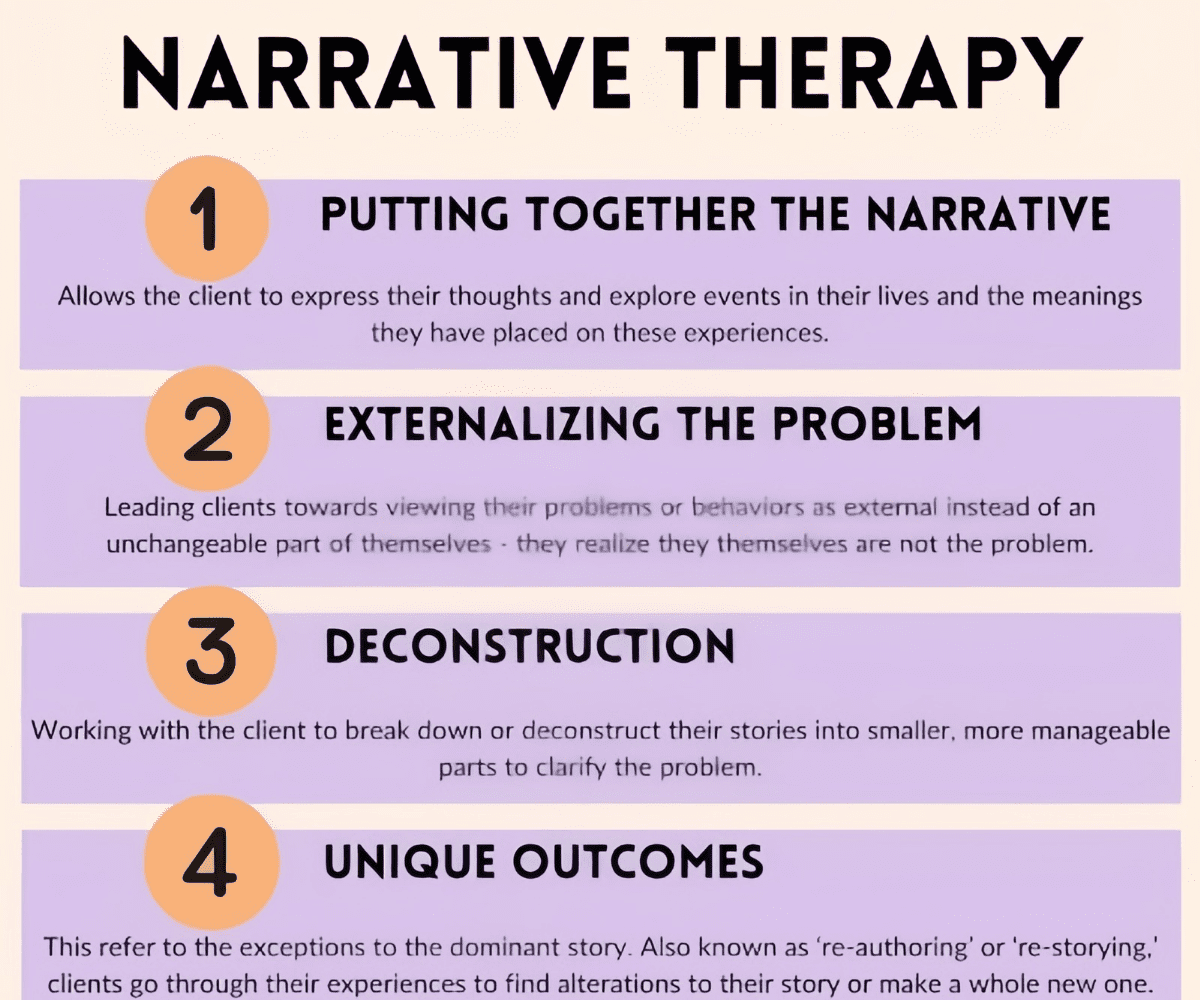Narrative Therapy Techniques: Ultimate Guide
Narrative therapy is a type of counseling that helps people see their lives from a new perspective. It is based on the idea that our lives are shaped by the stories we tell ourselves and others.
In narrative therapy, the therapist listens closely to the client’s story. Moreover, they help find new, positive ways to tell it. The aim is to let the client take charge of their own story, instead of letting negative or limiting stories control them.

Key Principles of Narrative Therapy
Narrative therapy is based on several key principles:
People are Experts in Their Own Lives
The client is see as the expert on their own life, experiences, and stories. Moreover, the therapist acts as a collaborator and facilitates the client’s exploration of their narrative.
Stories Shape Reality
The stories we tell ourselves about our lives have a profound impact on how we perceive and experience the world around us. Moreover, by changing our stories, we can change our realities.
Problems are Externalized
Narrative therapy encourages clients to externalize their problems, separating the issue from their identity. Moreover, this helps to reduce self-blame and create a sense of agency in addressing the problem.
Unique Outcomes
Therapists help clients identify instances where they have acted in ways that contradict the dominant, problematic narrative. These unique outcomes can be used as a foundation for building a more positive story.
Context is Crucial
Narrative therapy recognizes that our stories are heavily influenced by the cultural, social, and historical contexts in which we live. Moreover, understanding these contexts can help clients gain insight into their narratives.
Common Narrative Therapy Techniques
Narrative therapists employ a variety of techniques to help clients re-author their life stories. Here are some of the most common:
Externalizing Conversations
This involves separating the problem from the person, giving it a name, and discussing it as an external entity. Furthermore, this helps clients see that they are not the problem, but rather that the problem is the problem.
Deconstructing Dominant Narratives
Therapists help clients identify and challenge dominant narratives that may be limiting or oppressive. Moreover, this can involve exploring the origins of these narratives and their potential biases or inconsistencies.
Mapping the Influence of the Problem
Clients are ask to map out the influence that the problem has had on their lives, relationships, and sense of identity. This can help them gain perspective and see how the problem has been shaping their narrative.
Identifying Unique Outcomes
Therapists work with clients to uncover instances where they have resisted or overcome the problem, even in small ways. These unique outcomes can be amplified and used to construct a more positive narrative.
Re-Authoring Conversations
Clients are encouraged to re-author their life stories, incorporating the unique outcomes and alternative narratives that have been identified. Moreover, this process can involve writing, role-playing, or other creative exercises.
Getting Help from Loved Ones
Narrative therapists might ask family or friends to join therapy sessions. These supportive people can back up the client’s new story and offer different views.
Benefits of Narrative Therapy
Narrative therapy can offer numerous benefits to individuals seeking personal growth or healing from various challenges. Some of the key benefits include:
Increased Self-Awareness
By exploring their life stories, clients gain greater insight into their beliefs, values, and the narratives that have shaped their experiences.
Empowerment
Narrative therapy emphasizes the client’s agency and ability to shape their own life story. Moreover, this can foster a sense of empowerment and personal growth.
Better Relationships
When people change their stories, they might learn more about themselves and how they relate to others, which could make their connections more satisfying.
Less Shame and Self-Blame
Talking about the issue as something outside of themselves can help people feel less ashamed or blame themselves less, encouraging them to be kinder to themselves and bounce back easier.
Respects Different Cultures
Narrative therapy understands that our backgrounds and cultures shape our stories, so it’s sensitive to these influences, making it suitable for diverse groups of people.

Conclusion
Narrative therapy understands how stories shape our lives. It helps people rewrite their stories in a better, stronger way, which can help them grow, know themselves better, and heal. Whether you’re facing a tough time or just want to understand yourself better, narrative therapy can give you helpful insights and support as you learn more about yourself.
FAQs
-
Is narrative therapy only for individuals, or can it used with families or couples?
Narrative therapy works well in different places like one-on-one therapy, counseling for couples, and family therapy. It helps to understand and change the stories and experiences we share in our relationships.
-
How long does narrative therapy typically last?
How long someone does narrative therapy can change based on what they need and want. Some people might do it for a short time, while others might do it for a longer time to really understand and change their stories. Moreover, the therapist and client work collaboratively to determine the appropriate length of treatment.
-
Can narrative therapy combined with other therapeutic approaches?
Sure! Narrative therapy can combined with other types of therapy like CBT or mindfulness. Lots of therapists mix different methods to help their clients in the best way possible.
-
Is narrative therapy suitable for children or adolescents?
Narrative therapy can be adapted for use with children and adolescents. Moreover, therapists can use fun and imaginative methods like stories, art, or comparisons to help kids explore and rewrite their own stories.
-
How does narrative therapy address trauma or past experiences?
Narrative therapy recognizes that our narratives are shaped by our experiences, including traumatic events. Furthermore, therapists can help clients externalize the trauma and explore how it has influenced their narratives. By re-authoring their stories, clients can develop a sense of agency and resilience in the face of past trauma.
Moreover, this information is just for learning, not for replacing a doctor’s advice. If you’re really worried about your mental health, talk to a qualified mental health expert.
For more, Click here

